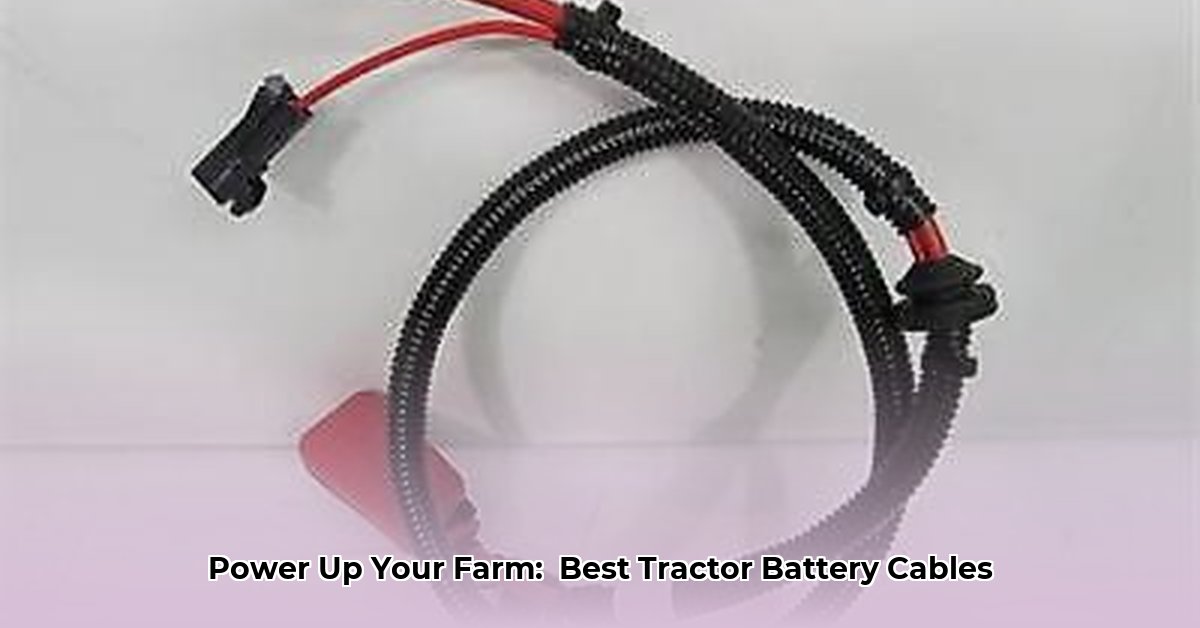
Understanding Your Farm's Power Needs and Battery Cable Basics
Reliable power is the lifeblood of a sustainable farm. From tractors and irrigation pumps to electric fencing, your equipment relies on consistent, efficient power delivery. This means choosing the right battery cables is crucial, and Tractor Supply Company (TSC) offers a range of options to meet your needs. Ignoring this seemingly small detail can lead to costly downtime, reduced yields, and increased environmental impact. What's the secret to seamless farm operations? Selecting the right battery cables. Let's explore how. For more information on TSC's offerings, check out their battery cable selection guide.
Decoding Tractor Supply's Battery Cable Options: Gauge, Material, and Length
Tractor Supply provides a variety of battery cables, each designed for different applications and power demands. Understanding the key specifications will ensure you choose the most suitable option for your specific needs.
Gauge: Thickness Matters
The cable gauge, a number stamped on the cable, indicates its thickness. Lower numbers signify thicker cables, which can carry more electrical current (amperage). Think of it like a water hose – a thicker hose carries more water, and a thicker cable carries more electricity. A high-amperage tractor needs a lower gauge cable (e.g., 2 gauge) than a smaller pump (e.g., 8 gauge). Incorrect gauge selection leads to overheating and potential failure. Always check your equipment's manual for the recommended amperage. Did you know that using an incorrectly sized cable is one of the leading causes of equipment failure in farming?
Material: Copper vs. Aluminum
Tractor Supply offers cables made of copper or copper-clad aluminum. Copper boasts superior conductivity, ensuring efficient power transfer. It’s more expensive but offers longer life and greater reliability, especially for high-amperage applications. Aluminum is a more budget-friendly option, but you'll need a thicker gauge (lower number) to carry the same current. Which material is superior for sustainable farming practices? While copper's upfront cost is higher, its longevity and superior performance represent a long-term economic benefit, reducing replacements and downtime.
Length: Avoid Shortfalls and Excess
Cable length is critical. Too short, and you'll strain connections; too long, and you risk damage or tripping hazards. Measure the distance between your battery and equipment, then add extra for slack and easy maneuvering.
Selecting the Right Cable: A Step-by-Step Guide
Choosing the right cable involves careful planning. Follow these steps to ensure optimal performance and longevity:
Determine Amperage: Consult your equipment manuals for its amperage rating (measured in Amps). This dictates the cable's current-carrying capacity.
Select the Gauge: Use a cable gauge chart (see below) or an online calculator to select the appropriate gauge based on the amperage determined in Step 1. Always err on the side of caution and choose a slightly thicker cable.
Measure Cable Length: Measure the distance between the battery and your equipment, then add extra length for flexibility and maneuvering.
Choose Material: Decide between copper (superior conductivity, higher cost) or aluminum (more affordable, requires a thicker gauge).
Inspect for Quality: Before purchasing, thoroughly inspect the cable. Look for any signs of damage, kinks, or frayed insulation.
| Amperage (Amps) | Recommended Copper Gauge | Recommended Aluminum Gauge |
|---|---|---|
| Under 50 Amps | 8 Gauge | 6 Gauge |
| 50-100 Amps | 6 Gauge | 4 Gauge |
| 100-200 Amps | 4 Gauge | 2 Gauge |
| Over 200 Amps | 2 Gauge | 1/0 Gauge |
Installation and Maintenance: Maximizing Cable Lifespan
Proper installation and ongoing maintenance are key to preventing premature cable failure:
Clean Terminals: Clean battery terminals and cable ends with a wire brush to remove any corrosion before connecting.
Secure Connections: Use appropriately sized connectors and tighten them firmly.
Protect Cables: Route cables carefully, protecting them from sharp edges, excessive heat, and corrosive substances.
Regular Inspections: Regularly inspect cables for wear and tear. Replace any damaged cables immediately.
Case Study: The Power of Prevention
A local farmer, experiencing frequent irrigation pump failures, traced the problem to undersized battery cables. Switching to properly sized cables from TSC resulted in zero downtime and significant cost savings in repairs and lost yield. This highlights the critical role of proper cable selection in maintaining efficient and sustainable farming practices. This farmer's experience is a testament to the investment's potential for return.
Cost-Benefit Analysis: Long-Term Sustainability
While premium cables may seem expensive initially, their longevity and reliability dramatically reduce long-term costs. Lowering downtime translates to increased yield, reduced repair expenses, and a more environmentally friendly approach to farming. The initial investment in quality battery cables is clearly an investment in sustainable agriculture's profitability and resilience.
Conclusion: Power Your Farm to Success with Tractor Supply
Reliable power is paramount for sustainable farming. Choosing the right battery cables from Tractor Supply Company is a critical step in ensuring efficient, reliable operations. Remember, the investment in high-quality cables translates into savings on downtime, repairs, and ultimately, a more prosperous and sustainable farm. Visit your local TSC store today and let their experts guide you in selecting the ideal cables for your needs.